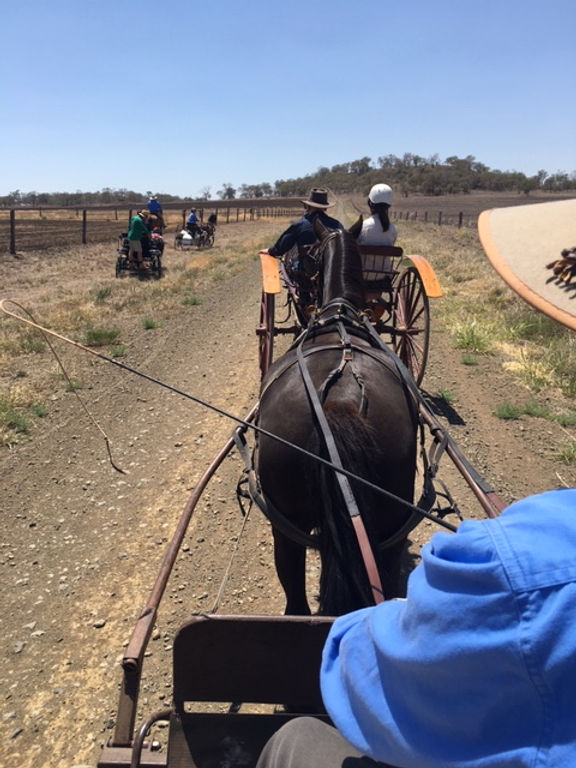

Combined Driving Events (CDE)
CDE Is carriage driving's answer to eventing. It is comprised of three sections: dressage, the marathon (including roads and tracks and obstacles (in lieu of jumps!)) and cones (the equivalent of showjumping). It can take place over 1, 2 or 3 days and can be outdoors or indoors.
Competition A -
Presentation (A1) and Dressage (A2) In Presentation the whole turnout, horse, vehicle, harness, driver and groom, is judged. Driven Dressage, is similar to ridden dressage, with specific movements performed in an arena. Tests require the driver to display control through voice, whip and reins, and the horses must display obedience, impulsion and correct paces.
Competition B -
The Marathon or Cross Country Many consider this is the most exciting phase of the overall competition. Horses need to be fit to cover the distance of up to 22km in the required time. The course is divided into five timed sections A - E, and includes two walks (Secs. B & D) of approx. 1km and a fast trot section (C). Each height class has different times for each section and time penalties may be incurred. Section E includes up to 8 man-made or natural obstacles (including water) which are gated using letters from A-F and can be driven in various ways, within a set time, as long as the gates are passed through in order.
Competition C -
Cone Driving The Cone Driving is designed to test the fitness, obedience and suppleness of the horse or pony after the rigors of the Marathon along with the skill of the driver..

Show Driving
Show driving events, often termed harness classes, can be seen at most agricultural shows including Royal Shows and are often divided into light and heavy horse sections.
Programs typically include classes for turnouts, for horses and ponies and for drivers. In turnout classes the horse, vehicle, harness and general appearance are judged, whilst the other classes concentrate on the performances of the horses/ponies or on the drivers.
Classes for light harness horses and ponies are usually divided into height groups, and are sometimes also divided by breed such as hackney and non hackney. Horses and ponies are judged according to the way they perform at different paces, in their individual workouts. Vehicles often used in the light harness show ring include viceroys and buggies (4 wheelers) and sulkies, jinkers and gigs ( 2 wheelers).
Heavy horses are catered for in the Business and Delivery classes, with divisions of classes often according to trade or to the type of heavy horse. Tradesman’s carts and vans, breaking in gigs, delivery wagons and drays are typically seen, being pulled by single horses as well as pairs and teams.

Pleasure, Endurance and Historical Driving
A Pleasure drive can be simply a drive down a country lane, rail trails, a picnic or campfire shared with like minded company held on one day, a weekend or even for a week in public reserves or private property. A great way to see the countryside, socialise, swap tips and educate a horse.
Other activities which you can enjoy under the Pleasure driving banner include navigation drives, endurance driving and good old fashioned fun days where club members get together for a great social event.
You can participate in Park which give you the opportunity to dress up and enjoy wonderful venues. These can be described as a "Show on the move". Usually held in scenic surrounds such as Botanical Gardens or historical parks and gardens, a Private drive was originally devised as a gentle competition for "private" vehicles (ie. Non-tradesman).
Events may cater for several classes and always include at least one Period Turnout class. Vehicles may vary greatly from original through to the modern and any type of horse from the miniature to Clydesdale may be entered. The event is judged at the halt as a turnout and then entrants set off on a leisurely trot around the grounds for several kilometres. Whilst out on the course more judging takes place, this time including the manners of the horse and the skill of the driver or "whip".

Driven Dressage
The object of the dressage test is to judge the freedom, regularity of pace, harmony, impulsion, suppleness, lightness, ease of movement and correct bending of horses and ponies on the move. Dressage is basic training.
The competitors are also judged on their style, accuracy and general command of their horse(s) and on the presentation of the turnout. The competition may be conducted as part of a CDE or as a stand-alone competition. Set movements and prescribed paces are required to be performed in a defined arena.
Driven Dressage arenas measure 100m x 40m (usually Open and Multiple but not exclusively) or 80m x 40m (usually Novice but not exclusively)


